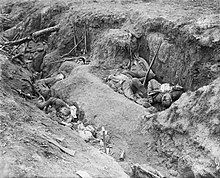WwI British Infantry & German Infantry 2 complete sets of toy soldiers
Western Front 1914 to 1916
Main article: Western Front (World War I)
Trench warfare begins
British Indian soldiers digging trenches in Laventie, France, 1915
Pre-war military tactics that had emphasised open warfare and the individual rifleman proved obsolete when confronted with conditions prevailing in 1914. Technological advances allowed the creation of strong defensive systems largely impervious to massed infantry advances, such as barbed wire, machine guns and above all far more powerful artillery, which dominated the battlefield and made crossing open ground extremely difficult.[84] Both sides struggled to develop tactics for breaching entrenched positions without suffering heavy casualties. In time, however, technology enabled the production of new offensive weapons, such as gas warfare and the tank.[85]
After the First Battle of the Marne in September 1914, Allied and German forces unsuccessfully tried to outflank each other, a series of manoeuvres later known as the "Race to the Sea". By the end of 1914, the opposing forces confronted each other along an uninterrupted line of entrenched positions from the Channel to the Swiss border.[86] Since the Germans were normally able to choose where to stand, they generally held the high ground, while their trenches tended to be better built; those constructed by the French and English were initially considered "temporary", only needed until an offensive would destroy the German defences.[87] Both sides tried to break the stalemate using scientific and technological advances. On 22 April 1915, at the Second Battle of Ypres, the Germans (violating the Hague Convention) used chlorine gas for the first time on the Western Front. Several types of gas soon became widely used by both sides and though it never proved a decisive, battle-winning weapon, it became one of the most feared and best-remembered horrors of the war.[88][89]
Continuation of trench warfare
German casualties at the Somme, 1916
In February 1916, the Germans attacked French defensive positions at the Battle of Verdun, lasting until December 1916. The Germans made initial gains before French counter-attacks returned matters to near their starting point. Casualties were greater for the French, but the Germans bled heavily as well, with anywhere from 700,000[90] to 975,000[91] casualties suffered between the two combatants. Verdun became a symbol of French determination and self-sacrifice.[92]
The Battle of the Somme was an Anglo-French offensive from July to November 1916. The opening day on 1 July 1916 was the bloodiest single day in the history of the British Army, which suffered 57,500 casualties, including 19,200 dead. As a whole, the Somme offensive led to an estimated 420,000 British casualties, along with 200,000 French and 500,000 Germans.[93] Gunfire was not the only cause of death; the diseases that emerged in the trenches were a major killer on both sides. The living conditions led to disease and infection, such as trench foot, lice, typhus, trench fever, and the 'Spanish flu'.[94]
WwI British Infantry & German Infantry 2 complete sets of toy soldiers
Western Front 1914 to 1916
Main article: Western Front (World War I)
Trench warfare begins

British Indian soldiers digging trenches in Laventie, France, 1915
Pre-war military tactics that had emphasised open warfare and the individual rifleman proved obsolete when confronted with conditions prevailing in 1914. Technological advances allowed the creation of strong defensive systems largely impervious to massed infantry advances, such as barbed wire, machine guns and above all far more powerful artillery, which dominated the battlefield and made crossing open ground extremely difficult.[84] Both sides struggled to develop tactics for breaching entrenched positions without suffering heavy casualties. In time, however, technology enabled the production of new offensive weapons, such as gas warfare and the tank.[85]
After the First Battle of the Marne in September 1914, Allied and German forces unsuccessfully tried to outflank each other, a series of manoeuvres later known as the "Race to the Sea". By the end of 1914, the opposing forces confronted each other along an uninterrupted line of entrenched positions from the Channel to the Swiss border.[86] Since the Germans were normally able to choose where to stand, they generally held the high ground, while their trenches tended to be better built; those constructed by the French and English were initially considered "temporary", only needed until an offensive would destroy the German defences.[87] Both sides tried to break the stalemate using scientific and technological advances. On 22 April 1915, at the Second Battle of Ypres, the Germans (violating the Hague Convention) used chlorine gas for the first time on the Western Front. Several types of gas soon became widely used by both sides and though it never proved a decisive, battle-winning weapon, it became one of the most feared and best-remembered horrors of the war.[88][89]
Continuation of trench warfare

German casualties at the Somme, 1916
In February 1916, the Germans attacked French defensive positions at the Battle of Verdun, lasting until December 1916. The Germans made initial gains before French counter-attacks returned matters to near their starting point. Casualties were greater for the French, but the Germans bled heavily as well, with anywhere from 700,000[90] to 975,000[91] casualties suffered between the two combatants. Verdun became a symbol of French determination and self-sacrifice.[92]
The Battle of the Somme was an Anglo-French offensive from July to November 1916. The opening day on 1 July 1916 was the bloodiest single day in the history of the British Army, which suffered 57,500 casualties, including 19,200 dead. As a whole, the Somme offensive led to an estimated 420,000 British casualties, along with 200,000 French and 500,000 Germans.[93] Gunfire was not the only cause of death; the diseases that emerged in the trenches were a major killer on both sides. The living conditions led to disease and infection, such as trench foot, lice, typhus, trench fever, and the 'Spanish flu'.[94]
|
|
|
|
|

The complete eBay Selling Solution.
